How Much My Blue Sapphirw Ing Is Worth
Deal Alert: Save 25% off at Blue Nile! Please enter your email address to receive your personal one-time use unique coupon code for 25% off engagement rings:
The history of sapphire gemstones being used in jewelry is long and storied. Whether using a sapphire as the centerpiece of your jewelry or adding sapphires to add a little color and accentuate your diamonds, sapphire gemstones are gorgeous and versatile. Before deciding whether to purchase a sapphire jewelry piece, there are many questions to answer.
Here's what we'll cover in this article:
What is a Sapphire?
What is the Color of a Sapphire?
What Are Sapphires Made Of?
What to Look For When Buying a Sapphire?
Are Sapphires Expensive?
What Do Sapphires Cost in 2022?
Are Sapphires Cheaper Then Diamonds?
Where is the Best Place to Buy a Sapphire?
Bottom Line Recommendation
What is a Sapphire?
A sapphire is a precious gemstone from the corundum mineral. They are commonly known for their striking blue color, though they do appear in a number of other color varieties. Sapphires have an incredible history, from drawing fame with the royal family to playing a part in ancient legends. Thus, sapphires are one of the most sought-after gemstones for jewelry (alongside diamonds).
What Does a Sapphire Look Like?
When many people think of a sapphire, they think of a gem with a seductive deep-blue color. While blue sapphires are most popular, they can actually come in a range of colors. Along with blue sapphires, you can also find them in pink, purple, yellow, green, white and more.
As a naturally-formed gemstone, sapphires almost always have slight flaws and inclusions. This isn't a drawback — it actually proves that a sapphire is genuine and makes it unique. If a sapphire appears flawless, it's most likely a lab-created sapphire.

What Are Sapphires Made Of?
Sapphires come from the mineral corundum, which is a crystallized form of aluminium oxide. Corundum forms in crystalline rocks, which contain what we know as sapphires or rubies, based on other minerals present during formation.
It's this mix of minerals that work together over thousands of years to produce beautiful, rare, coveted gemstones like the sapphire.
Corundum is an extremely hard substance, just about on par with the hardness of a diamond. For this reason, sapphires are extremely durable and don't scratch easily. They score a 9 on a scale of 1 to 10 on the Mohs' scale of mineral hardness, second only to diamonds at a perfect 10.
Lab-Created Sapphires
While natural sapphires take thousands of years to properly form, scientists have been able to hack the process to create man-made sapphires in much less time.
Lab-created sapphires come from synthetic forms of corundum, used to make synthetic sapphires, and rubies (the other precious gem made from corundum). Since both natural and synthetic sapphires come from the same mineral, lab-created gems are essentially the same as their natural counterpart, with the same visual qualities and hardness. Lab-created sapphires are less expensive, however, due to the reduced rarity and faster creation process.
The easiest way to tell between a natural and lab-created sapphire is the flawlessness. Natural sapphires will have small inclusions or flaws throughout the stone if you look closely. However, lab-created gems are designed without any of nature's unpredictability and are therefore clean and flawless.
Despite lab-created stones containing no visual flaws, natural sapphires are more sought-after, and thus more expensive (especially rare or high-quality natural sapphires, such as Kashmir sapphires).
What Does a Sapphire Mean?
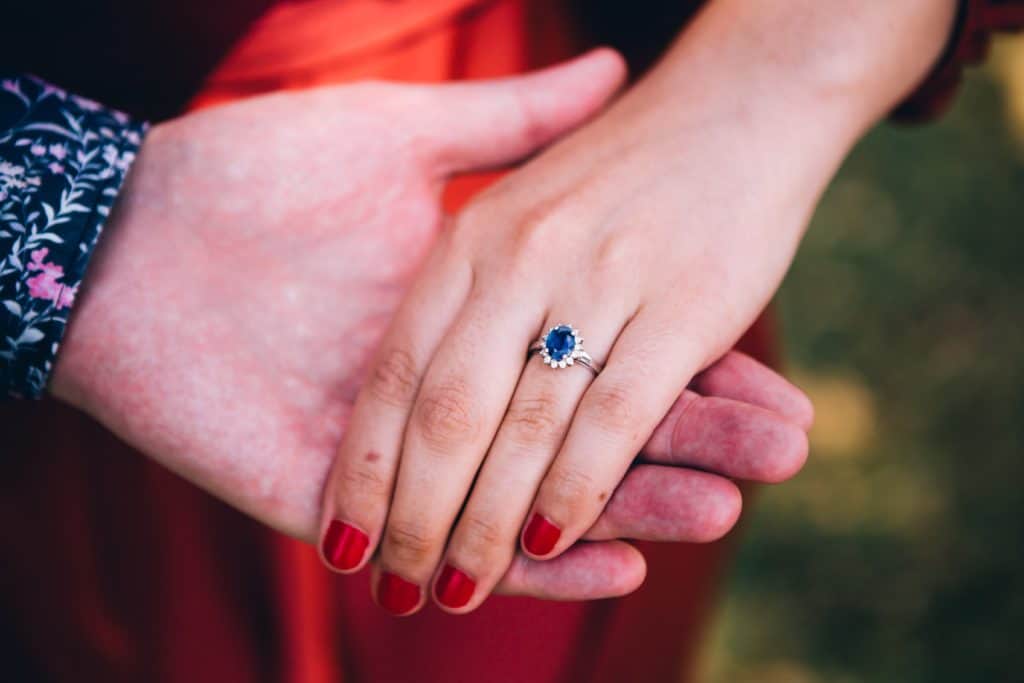
Sapphires have a wealth of historical meaning, which is part of what makes them so cherished. Throughout time, the sapphire has been known as a prized and valuable gemstone, with their deep blue allure reaching out to many people in history.
The word itself is generally accepted to be derived from the Latin and Greek terms for "blue", though some believe it comes from the Sanskrit word for Saturn. In fact, in many languages the term sapphire can be loosely translated to mean "dear to Saturn".
The word sapphire may also come from the Hebrew "sapir," as it is understood in the Hebrew Bible to refer to blue sapphires.
Sapphire is September's birthstone and the traditional wedding anniversary gift for the 5th and 45th year.
Sapphires & Royalty
Sapphires have been the darling gemstone of the royalty and well-to-do for centuries, so it's no surprise that they've gained in popularity of late as the center stone or accent stone in bridal and fashion jewelry.
The fact Prince William proposed to Kate Middleton with his mother's 18 carat blue sapphire engagement ring certainly set quite the precedent, and has sparked a growing trend amongst couples searching for colored gemstone engagement rings.
However, before Princess Di received her gorgeous blue beauty, these indigo rocks had been cherished for generations as symbols of good fortune, virtue, holiness, and wisdom.
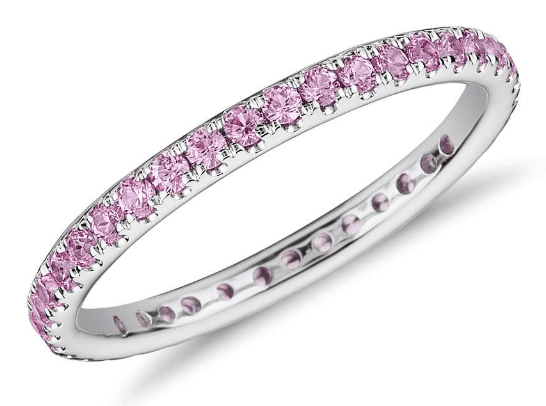
What Does Sapphire Mean in the Bible?
Sapphires appear frequently in the Bible. The stone is mentioned in many chapters, representing something beautiful or precious, with significant value. Most notably, a legend holds that the tablets of the Ten Commandments were made of sapphire and were so strong that they could withstand a hammer's swing but would smash the hammer to pieces if struck.
Sapphire in Legends
The ancient Persians believed that the earth rested on a giant sapphire, which reflected its color to the sky. In many cultures, blue sapphire represents the heavens. The sapphire holds a notable place in Ancient Greek and Indian history too. Buddhism also holds the sapphire in high regard, believing the sapphire has a calming presence that can help bring about spiritual enlightenment.
The Four C's of Sapphires
Color
Color is the most important factor when purchasing a colored gemstone. The color of the sapphire is what captivates us, and draws us in for a closer look.
But this is only when the color of the stone has the proper measures of hue, tone, and saturation. Without these, the stone may appear dull, colorless, and gray.
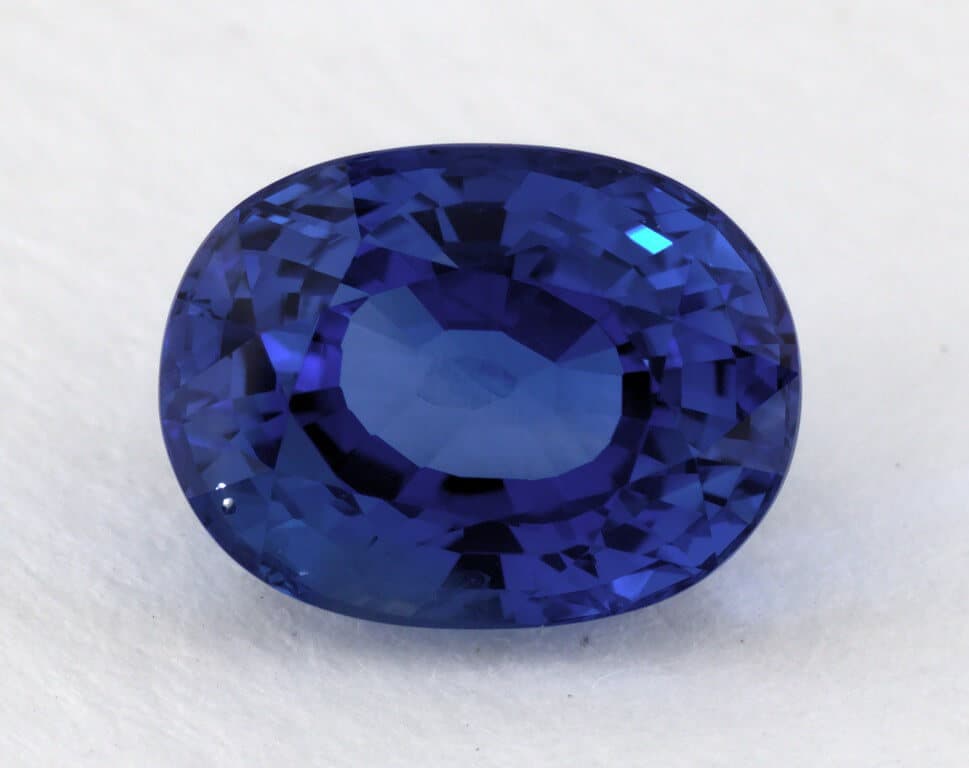
Sapphire Hue
A sapphire's hue describes the stone's balance of color as it relates to its neighbors on the color wheel. With blue sapphires, for example, we would call the stone's color either blue, slight green, strong green, slight purple, or strong purple.
The closer you can get to "true" blue, the more expensive and desirable the sapphire will be. It's common to refer to this variety of sapphires as "cornflower blue," as the cornflower is one of the few flowers said to be purely blue and not violet or purple like most other "blue" flowers.
Yogo sapphires, mined in Yogo Gulch, Montana, are said to be of this cornflower blue variety, and are famous for their lack of inclusions (high clarity).
Sapphire Tone and Saturation
Tone describes how light or dark the color is with the range going from very light to very dark. It's best to stay in the medium to dark range with tone, as the lighter the tone, the more watered down the overall look of the sapphire.
And finally, the saturation describes how vibrant the color is with the range going from dull/weak to pure vivid. The closer to pure vivid you can get, the better the sapphire's color will appear to you, and the more money it will fetch.
As we said, the most desirable sapphires will have vivid, highly saturated color without areas of brown or gray. These areas are known as extinction and are affected by lighting quality, position, tone, and cut. Usually the darker the stone's color, the darker the extinction will be as well.
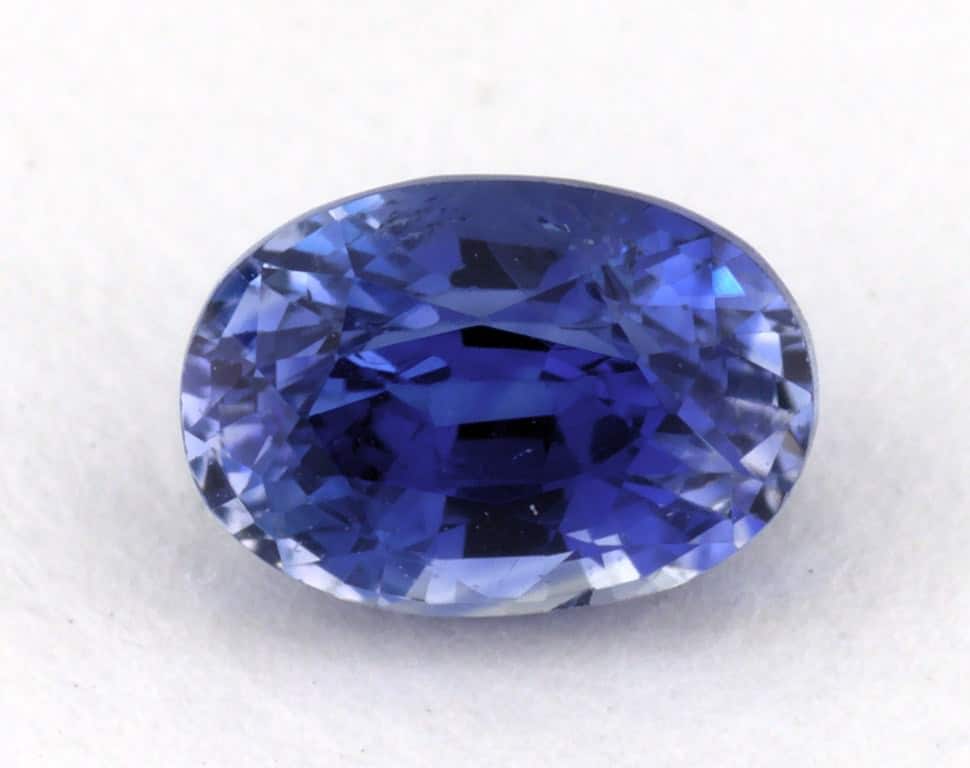
Color Grading Issues
Whereas diamonds have an elaborate, standardized color-grading system, sapphires and other colored gemstones have no such similar way to assess color across the board.
This lack of uniformity means that it's harder to compare two sapphires since one won't be graded "D" and other "J."
Rather, you will have use your own judgment about which colors appear vibrant and alive to you. Of course, the better the sapphire's color, the higher the price tag will usually be, but be sure to buy only from reputable gemstone vendors.
The Padparadscha Sapphire
Besides the renowned blue sapphire, there is the Padparadscha Sapphire, an extremely rare and sought-after pink-orange fancy sapphire originally found in Sri Lanka.
This sapphire can fetch over $20,000 per carat! The name comes from Sanskrit/Sihalese "padma raga," which means "lotus color" since the stone's color is reminiscent of a lotus flower.
Fancy Pink Sapphire
After the blue and Padparadscha, the fancy pink sapphire ranks third in popularity for its prized hot pink hue. These striking pink marvels are generally found in Burma or Sri Lanka.
As the amount of chromium increases in the corundum, the shade of pink deepens as well. It is important to note that there is often a fine line between what is called a pink sapphire and a red ruby.
You can find treated sapphires that look nice, like this pendant from Amazon. But the color just doesn't look quite the same.
In the United States, there must be a minimum color saturation in order for the stone to be called a ruby. In other places, the term ruby may be used more loosely.
Clarity
It is highly unlikely to find sapphires without any inclusions, or imperfections, at all. If there are no inclusions, gemologists will suspect the sapphire to be fake or treated. As we explained in our article about rubies, all sapphires will have rutile needles or "silk".
Most sapphires on the market today have been heat-treated to improve their clarity and color. (If they've not been treated at all, they can be sold for big money.)
Whereas with diamonds, gemologists use 10x magnification to inspect the diamond's inclusions, with colored gemstones, we are only concerned with non-magnified careful examination.In other words, we are looking to see if the stone is "eye-clean" to the naked eye. The cleaner the stone, the higher the price tag.
Sapphire Inclusions
While the appearance of inclusions are not usually regarded as positive, in the case of asterism, the opposite is true. When light is reflected off the silk, a star effect is created, making the sapphire appear to have a three or six-point star on the face of the stone.
Asterism is rare and also increases the value of the stone. The Black Star of Queensland is said to be the largest mined star sapphire in the world, weighing in at 733 carats.
Cut
There are no standardized cuts for sapphires as there are with diamonds. Whereas with diamonds you could choose an "ideal" cut to showcase the diamond's color and fire, with sapphires — and most colored gemstones — you are relying on the gem cutter to maximize each individual sapphire's unique combination of color, clarity, and brilliance.
In general, a well-cut sapphire will be symmetrical and reflect light at the proper angles in order to enhance the stone's luster. It is often the case that gem cutters will cut more deeply when the sapphire's tone is light.
This makes the stone appear to have a deeper, darker color. And the opposite is also true: if the sapphire is very dark, then the gem cutter may choose to make a shallow cut to bring more light in and thereby lighten the overall look of the stone.
Common Shapes
The most common shapes of sapphires are usually oval, round, cushion, and emerald. The cabochon cut is also prevalent as a non-faceted, polished alternative. This shape displays the sapphire as a smooth oval, convex dome, and is the best way to show off a star sapphire's asterism.
Carat
Just as gemstones vary widely across the spectrum in terms of their color and hardness, so too they also differ in density. This is apparent when we consider the carats, or weight of the sapphire vis a vis the carat weight of a diamond.
Since sapphires are usually heavier, a one carat sapphire will look smaller than a one carat diamond. It is more accurate to measure the size of the sapphire in terms of its millimeter diameter. A rule of thumb is that a one carat sapphire generally measures 6 mm.
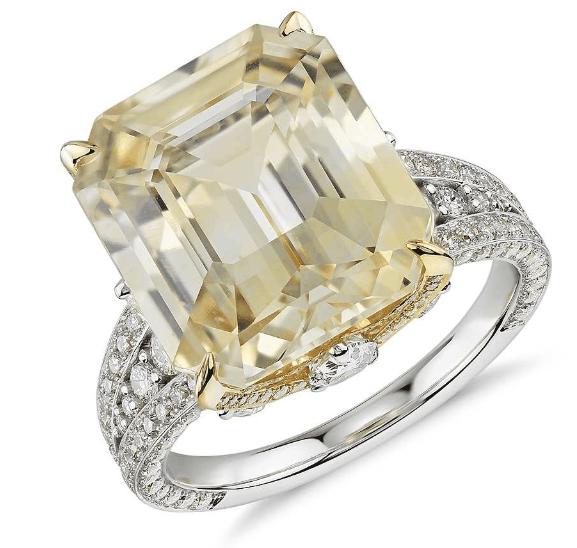
Sapphire Price
Sapphire prices can range greatly, depending on many factors. Sapphires can come as cheap as $25 per carat, to over $11,000 per carat. A blue sapphire around 1 carat is likely to cost from as little as $450 to $1,600, depending on quality.
The 4 C's outlined above make a big difference in the cost of the stone, as do the region they originate from. Color is the biggest factor in price. The most valuable sapphires are those with a powerful deep blue hue.
Lab-created sapphires will almost always come at a cheaper cost per carat than natural sapphires, as naturally-formed stones are rarer and more sought-after.
Sapphires from Kashmir, in the Indian Himalayan Region, are particularly cherished, and thus have a higher worth than others. They come originally from mines in the Zanskar range of the Himalayas, which is notoriously hard to access. Sapphires from Ceylon and Burma are said to have a similar appearance to Kashmir sapphires, however not quite the same standard.
In terms of color, pure blue sapphires are the most highly prized, and therefore tend to be the most expensive. This is one of the qualities of the Kashmir sapphire, said to be like "blue velvet" in their appearance.
Sapphire's Price Per Carat
For a high-quality sapphire, you're likely to see a cost of around $800-1,200 per carat. For more common sapphires, which are decent quality yet not especially remarkable, you will be looking at a little less, around $400-600 per carat.
Take this 0.79 carat blue sapphire from James Allen as an example, which is priced at $340 for just over a ¾ carat.
In comparison, look at this similarly sized pear shape from Blue Nile. Take away the price for the setting which can be around $1,300-$1,400, the sapphire costs around $120-$220.
Leibish & Co have a range of high-quality sapphires, mostly from Sri Lanka. A 1 carat sapphire here costs around $1,000-1,600. An example on the high end is this 0.99 cushion shape sapphire for $1,625.
Larger stones (3 carats or more) are more rare, and thus will command a higher price tag. Prices can range from around $5,000 for this 3.38 carat heart-shaped sapphire from Leibish & Co. , to over $80,000 for a 10ct+ blue sapphire.
Types of Sapphires
One of the reasons sapphires are so fascinating is the many varieties. Different chemical elements present when the sapphire forms can result in a range of different colors.
Blue sapphires are the most popular and most sought-after type of sapphire. The exact blue hue can vary, from a pale blue to a deep, intense royal blue. There is little as captivating as a perfect, intense blue sapphire.
Pink sapphires are another variety with their own allure. A sapphire will be created with a vibrant pink hue with the presence of chromium during the creation process. Pink sapphires are beautifully romantic, and increasingly popular for engagement rings.
Yellow sapphires are a captivating variation. The color is usually warm and vibrant, and complements most jewelry settings well. Yellow sapphires look very similar to yellow diamonds, but make a cheaper alternative.
Green sapphires are a lesser-seen, non-traditional variety. They can be quite pale or have a deep, intense hue, or something in the middle.
White sapphires are a type that look very similar to diamonds, and may be used as a cut-price alternative. The look is similar at first glance, however it won't have quite the brilliance and light a diamond has.
Another noteworthy type of sapphire is the Padparadscha sapphire. As we mentioned above, these are extremely rare, and have a captivating allure not many other styles can match. The exact color of a Padparadscha sapphire is hard to pinpoint, a tropical mix of pink and orange. This color matched with a rose-gold setting make for absolutely stunning pieces of jewelry.
Interestingly, there are no red sapphires. Technically, these are rubies. Rubies and sapphires both come from corundum, and it's the gemstone's hue that decides which one it is. At a certain color saturation, a red ruby will become a pink sapphire.
Sapphire vs. Diamond

While diamonds are the go-to stone for engagement rings and fine jewelry, the sapphire is growing in popularity. The color of a sapphire offers an interesting alternative to the classic, clear diamond. You can also save quite a significant amount by purchasing a sapphire rather than a diamond.
Sapphire necklaces and pendants are very popular, and sapphire engagement rings are coming up more often as well. A common setting for sapphire jewelry is a halo or pave setting. The deep blue sapphire in the middle of the piece is beautifully complemented by a ring of diamonds surrounding it. See this sapphire and diamond three stone engagement ring from Blue Nile which is another great example of style that goes well with the sapphire/diamond combination.
Head to head, diamonds are higher quality gems. While sapphires are hard and durable, they aren't as hard as diamonds. Because of this, a piece of diamond jewelry will be more resistant to scratches and less likely to wear down or become damaged.
Another pro for diamonds is how they refract light, resulting in the stunning brilliance diamonds are known for. A high-quality diamond will have a clear, brilliant sparkle all the time, while most sapphires won't quite be so radiant. This is especially noticeable with white sapphires, which at first glance look just like diamonds, but don't shine quite the same.
This is reflected in the price, so if you want a beautiful piece of jewelry for less, a sapphire can make a great alternative. A beautifully colored sapphire can catch attention as well as a diamond.
Sapphire vs. Diamond Price
Carat for carat, sapphires are almost always cheaper than diamonds. As an example, here is a 1.05 carat blue sapphire from James Allen , which costs $700. In comparison, a 1 carat diamond from James Allen costs over $4,000. Even sapphires on the high end price-wise won't match a diamond's price, such as this 1.13 carat blue sapphire from James Allen for $2,610.
Sapphire rings and diamond rings will often be a similar price, however, this is due to larger sized sapphires being used more often. To compare, these two rings from Blue Nile – an oval diamond in a three stone setting with baguettes and an oval sapphire in an identical setting – are similar prices. However, the diamond ring features a 1.20 carat center stone, while the sapphire ring is at least 1.50 carats.
Best Place to Buy Sapphires
Like any precious gem or piece of jewelry, it's important you shop with a quality vendor, to ensure the piece you're buying is up to standard and not overpriced.
James Allen is one of the best places to shop for fine jewelry online. Their products are superior quality to most other vendors, and they have a great range of blue, pink, yellow and green sapphires, which you can inspect in high-quality 360 degree images on their site.
Leibish & Co is another vendor that specialises in rare, high-quality gemstones and jewelry, and is especially good if you're looking to buy a sapphire. They have some of the most beautiful blue sapphires and sapphire jewelry you will find anywhere.
While not always the most reliable source for jewelry, Amazon has some sapphire jewelry as well. We would not recommend buying an expensive piece like an engagement ring on Amazon, but they may offer decent options for smaller pieces of jewelry like earrings.
Finally, Blue Nile has a small range of gemstone engagement rings and other pieces of jewelry. They do not sell loose sapphires, but the sapphire engagement rings they have are beautiful. See this pink sapphire and diamond micropavé ring as an example.
Bottom Line Recommendation:
Buying a Sapphire is much less technical than buying a diamond. Diamond's are treasured for their brilliance while sapphires are loved for their color. Since it's all about the color, you need to buy your sapphire from a site that has high-quality images of their stones, like James Allen or Leibish & Co.
Not only do these two companies offer loose gemstones, but they both make stunning jewelry with sapphires. Take this amazing three-stone sapphire (with diamond sidestones) ring from James Allen for example. Or if you are looking for something more subtle, here is a beautiful sapphire pendant with a diamond halo from Leibish & Co.. That said, you can also find beautiful jewelry elsewhere. Take this beautiful pair of sapphire earrings from Blue Nile for example.
If you want to see more sapphire engagement rings, check out our list of recently purchased rings from our highest-rated retailers.
Having trouble navigating the sapphire gemstone buying minefield? We are happy to help. CONTACT US
Buy Sapphires
Ready to buy? Here are some buying tips, whether you're shopping for a loose sapphire or a piece of sapphire jewelry.
- Focus on color . The color is the main attraction of a sapphire. Cut and clarity can take a backseat, as long as you ensure the gem has an attention-grabbing color. Look at the hue and saturation closely before deciding.
- Check the treatment . Sapphire treatment is something that will affect the price and quality of your gem. It's most common to find heat treated sapphires. Untreated sapphires command the highest price, while cheaper sapphires may be Beryllium treated or surface diffused. Don't get caught paying a high price for a heavily treated sapphire.
- Look at different colors . The classic blue sapphire is the most popular, but other variants, such as pink or yellow sapphires, can make for beautiful , unique pieces of jewelry.
- Don't be afraid of inclusions . While slight flaws in the gem might be cause for concern with a diamond, these are natural for sapphires. Don't look for a flawless sapphire, as this is likely to be lab-created, and less valuable than a natural one.
When you're ready to buy a sapphire, it's essential to see a high quality image of the stone for yourself. It would really be a foolish gamble to make a purchase without investigating the actual stone's hue, tone, and saturation.
Shop for gemstone engagement rings here.

James Allen James Allen is the leader in online diamond sales. Their imaging technology is the same as inspecting a diamond with a jeweler's loupe. They have the largest exclusive loose diamond inventory online and fantastic prices. They also have the nicest collection of lab created diamonds online. Save 10% off Lab Created Diamonds during limited time sale!
What we love about them:
- No questions asked returns within 30 days of shipment. James Allen will send you a paid shipping label to return the ring.
- Lifetime Warranty
- Free International Shipping
- Free prong tightening, repolishing, rhodium plating and cleaning every 6 months
- Provide insurance appraisals
- One free resizing within 60 days of purchase
- Free ring inscriptions
- Best-in-class high quality imagery of all diamonds in stock
- 24/7 Customer Service
- Best-in-class packaging


Blue Nile Blue Nile is the largest and most well known internet jewelry seller. They have a very large exclusive online inventory. Their high quality images are catching up to James Allens' and their prices are amazing. Blue Nile have generously offered our readers an exclusive one-time use coupon. (Click Here to save 25% off engagement ring settings) Please enter your email address to receive your personal one-time use unique coupon code for 25% off engagement rings:
What we love about them:
- No questions asked returns within 30 days of shipment. Blue Nile will send you a paid shipping label to return the ring.
- Lifetime Warranty
- Free Shipping
- Free prong tightening, repolishing, rhodium plating and cleaning every 6 months
- Provide insurance appraisal
- One free resizing within the first year of purchase
- High quality images of about half of their diamonds
- 24/7 Customer Service
- 100% credit towards future upgrades (must be at least double in value)
- Best in class fulfillment

Still afraid of getting ripped off?
Before you buy a diamond, get personal buying advice from industry veterans. We'll help you get the best diamond for the money.
Ask your diamond purchase question here
DISCLAIMER: We don't use your email for marketing. Period.
You Might Like
-
Diamond Prices: A Complete Guide
Buying a diamond is confusing. On the surface, it seems like nothing makes sense. Take a look at this 2 carat diamond from James Allen and compare it
-
Best Places to Buy Diamond Engagement Rings
We've visited and reviewed many diamond retailers, online and offline. In the process, we've come across several diamond engagement ring vendors
-
1 Carat Diamond Ring Buying Guide
Here's what we'll cover in this article: How much does a 1 carat diamond ring cost?How large is a 1 carat diamond?Where should I buy a 1 carat
Source: https://www.diamonds.pro/education/sapphires/

0 Response to "How Much My Blue Sapphirw Ing Is Worth"
Post a Comment